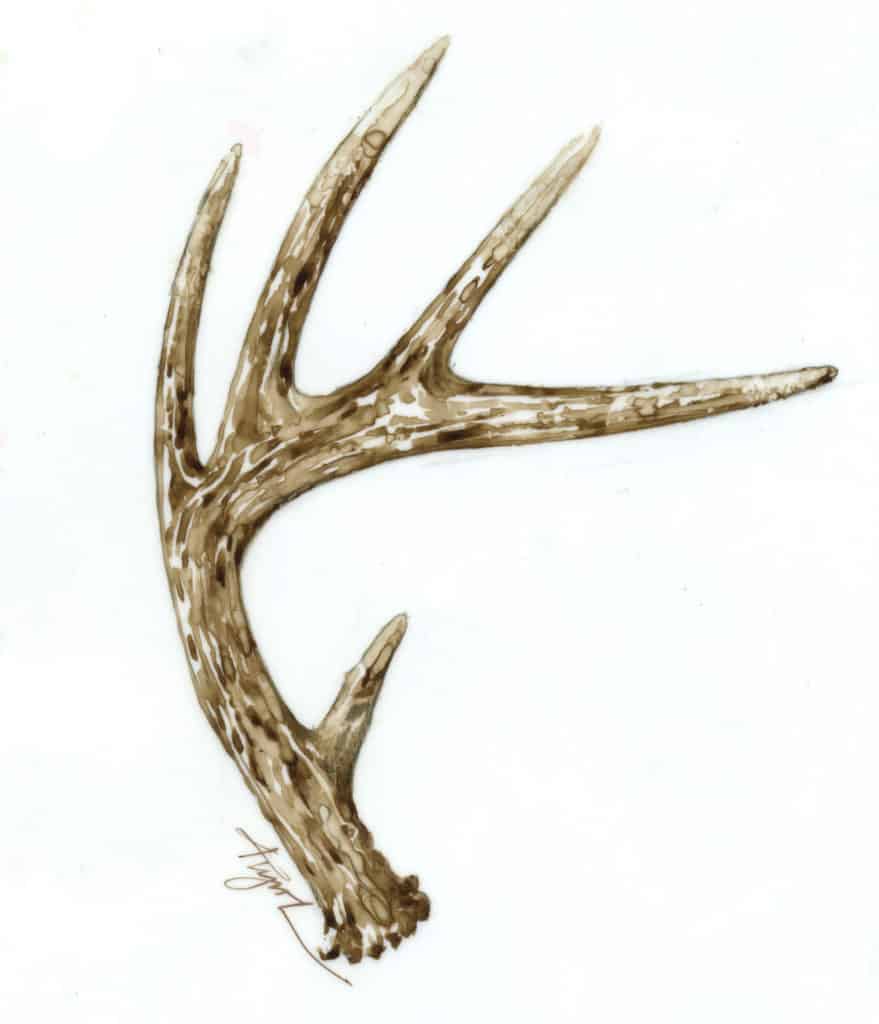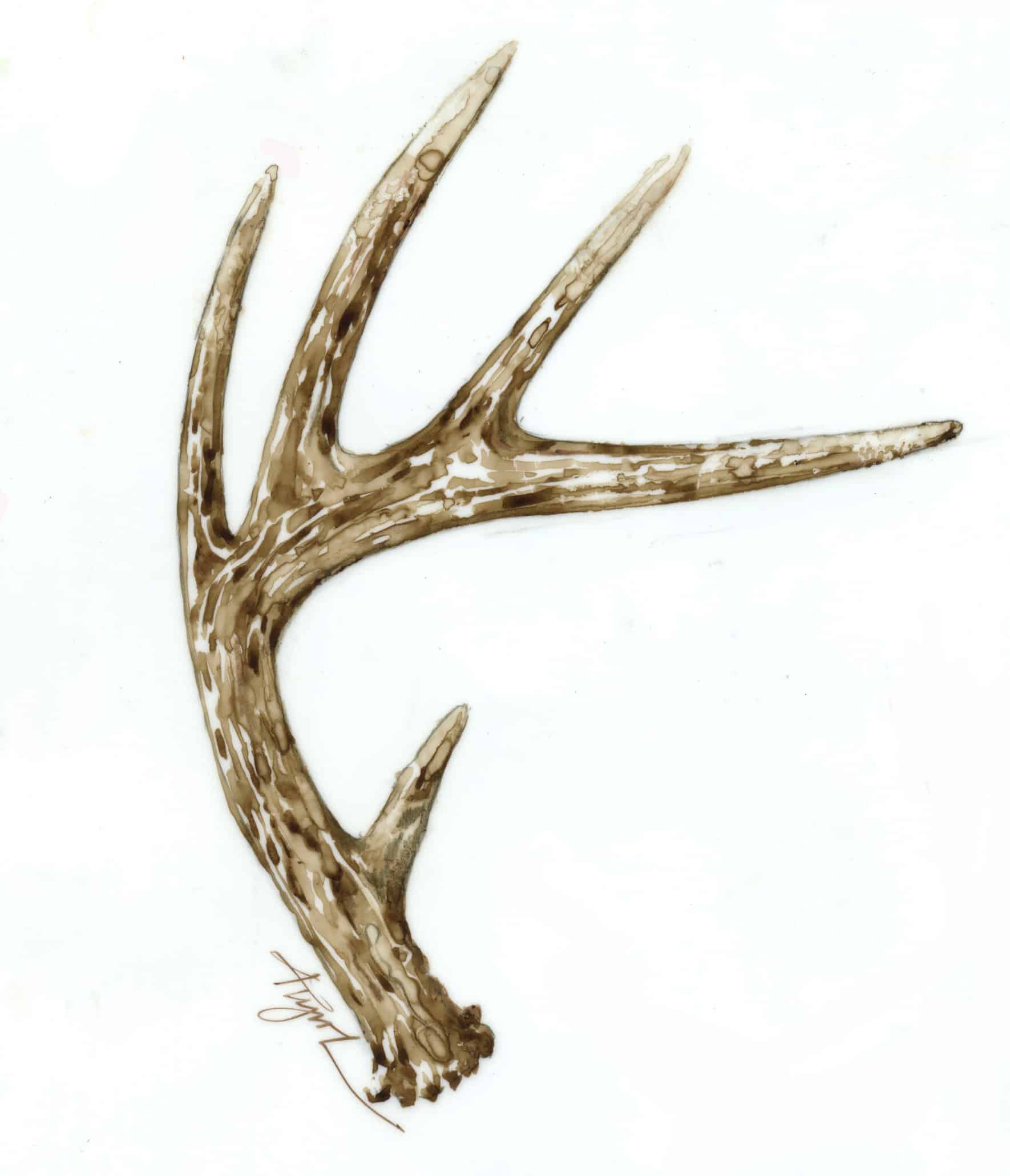
By Dave Mance III
The blast of a gunshot: a deep bass roar she feels in her chest, followed by a treble ringing in her ears. The buck drops. The hunter remains in her crouch, watching the animal’s last breaths through her scope. When he is still she rises, trembling from the cold and the moment, and approaches.
She takes in the expanse of his body – a coiled spring in life that seems pretend somehow in repose. She’s struck by the pure white hair on his belly, which seems unnaturally bright up close. Her eyes follow his swollen neck to his head, to his crown: the dark paired horns … er … antlers that are the same color as the tannin-stained water in the sphagnum bog from which he’d appeared. She smiles, imagining her grandfather bellowing, as he often did when his grandchildren misspoke: “They’re not horns; they’re antlers!” He was not a biologist, just a man who believed that words and details matter.
One crucial difference between a horn (cow) and an antler (deer) is that antlers are shed and regrow each year. In late winter this buck might have been mistaken for a doe. As the sap rose in the trees, his antlers started to grow – at their peak of growth in summer they might have put on 2 inches a week. When they were growing, they had skin, arteries, nerves, and bone. And so you can imagine antlers as limbs that the bucks regenerate each year, like the way a salamander can grow a new tail. Another way to make sense of things is to look at a growing antler like a tree. The velvet and skin on the surface is similar to bark, the bone beneath is similar to sapwood, and in between there’s a thin layer of tissue, called the periosteum, that functions like cambium.
The hunter touches the coronets – the regally-named flairs at the bottom of each antler. She touches the tip of each point. As she runs her hands along the beams she can feel the arteries that were beneath the velvet just a few months ago, etched into the bone like fossils. She touches the knobby pearlations at the base of the antler – they form where the periosteum merged with the connective tissue and skin on the outside of the antler. They’re full of bark, as the buck used them to rasp trees throughout his range when they hardened off. She smells the wood shavings and determines it’s spruce. The softwood pitch may account for the dark color of these antlers, or it could be that when the buck removed the velvet in September, the blood stained the bone. Both these theories attempt to explain the difference between these and the lighter, wheat-colored antlers of the farm-country bucks in the magazines and the sun-bleached racks that adorn the barn’s north wall.
They’re big, she thinks, her hand circled around the antler just above the brow tine. She knows that if her middle finger can just touch the base of her thumb the antler is roughly 3 inches in diameter. She estimates the spread, the length of the beams, and the length of each point; does some quick math and decides it’s a 140s-class buck. Her best buck yet.
How old was he, she wonders? She’d read a story in Northern Woodlands magazine recently, which said that you can’t accurately determine a deer’s age by the girth of an antler. The assertion was based on a study that analyzed data from 5,000 New Hampshire bucks and found that the thickest antlers were not the oldest. One of the lines she remembered almost verbatim from the story was that a deer with a 3-inch diameter antler could potentially be any age but a fawn. But that’s the thing about editors, she thinks. They get so enamored with outliers – with details that contradict conventional wisdom – that they lose sight of the big picture. Yes, this deer could technically be any age but a fawn. But the chances that he’s 1.5 are miniscule. She’s killed enough 2.5-year-old deer out of this gene pool to know that the antler mass here is likely too significant, and the chance that he’s older than 5 is diminished by the laws of averages on this heavily hunted mountain. She checks his coloration and the wear on his teeth for their insights, but even before she does she’s almost certain he’s a 3.5 or 4.5-year-old deer. Still, details matter. She will send a tooth in to have it professionally aged, a process that involves cutting a cross section and counting its rings like a tree.
She dresses the deer, then flips him to drain. She attaches a rope to his antlers, then leaving enough lead for leverage, attaches the other end to a stout pole. “He probably outweighs me by 40 pounds,” she thinks as she leans into the drag, smiling. What a nice problem to have.
Dave Mance III is the editor of Northern Woodlands, and yes, is enamored with outliers. The illustration for this column was drawn by Adelaide Tyrol. The Outside Story is assigned and edited by Northern Woodlands magazine and sponsored by the Wellborn Ecology Fund of the New Hampshire Charitable Foundation.




